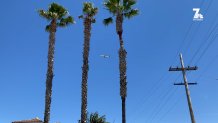The city and county of San Diego said the trees interfered with aircraft navigation.
"I am sorry, I wish that I could give you something . . . but I have nothing left. I am just an old stump. I am sorry" — "The Giving Tree," by Shel Silverstein
In the middle of a legal fight with the city of San Diego and the county airport authority over the removal of palm trees in Ocean Beach, city crews showed up and cut down five towering trees.
Tracy Van de Walker, who bought her home at the corner of Newport Avenue and Santa Barbara Street back in 2008, is outraged about the removal of a 70-80-foot Mexican fan palm that was in front of her home. Her two-story house is seemingly far from the flight path. Aviation officials, though, say the seemingly needle-thin palm trees, trimmed and healthy, posed a risk to navigation technology.

Get top local stories in San Diego delivered to you every morning. Sign up for NBC San Diego's News Headlines newsletter.
The battle over the palms began for Van de Walker back in October 2021, when she received a note from Ralph Redman, San Diego manager of airport planning, saying the trees would be removed “within the next few weeks.”
To the untrained eye, the tops of trees, located hundreds of feet below the flying fortresses taking off (and, occasionally, landing) from the runway at what was once known as Lindbergh Field appear to be no danger to aircraft landing at the airport, which is nearly three miles to the east.
The city put a target on these particular examples of Bismarckia noblis, however, after the airport conducted a survey in 2020, something done every 5-10 years.
Local
In November, the city said that no crews were scheduled to take down the trees and, further, that it would be conducting additional inquiries prior to doing so anyway. Clearly, that all changed this week.
The following is not in dispute: Early on Sunday morning, city workers showed up at and posted no-parking signs for Monday morning, which is when, at about 7:15 a.m., San Diego police officers showed up, as did city work crews that began to remove five palm trees, including one at Van de Walker's home.

Van de Walker said she found out about the tree removal when the no-parking signs went up and her husband asked if the workers putting them out were with the city's forestry department. She said the tree that was taken down was trimmed within the past month, so "obviously they had other plans for it," she said.
Unlike previously, however, Van de Walker said, there was no contact from the city about the removal of the tree.
"No letters this time, nothing, no communications, nothing," Van de Walker said. "As far as we knew, they were — we have a lawsuit and a court date, and the court date is set for July 15 of this year, and as far as we knew, they were just kinda gonna stand down until we went to court, and we were somewhat safe."
The Obecian said she thought the removal of the trees was timed in such a way as to prevent her and her husband from seeking a legal remedy to block their removal.
"Of course they put up the signs on a Sunday so you can't call the city, you can't get ahold of anyone, um, you can't try to get a restraining order against them doing anything 'cause all the courts are closed, everyone's off, everyone's doing their thing," Van de Walker said. "And then they come at 7:15 in the morning and [start working on the trees]."
"Of course they put up the signs on a Sunday so you can't call the city, you can't get ahold of anyone, um, you can't try to get a restraining order ..."
— Ocean Beach resident Tracy Van de Walker
According to websites of the downtown federal courthouses, they are closed on Sundays and open at 7 a.m. on Mondays.
Anthony Santacroce, a senior public information officer for the city of San Diego, told NBC 7 the tree removal was scheduled for the time it was "to mitigate really, for increased safety. We wanted to make sure to mitigate the chance that cars wouldn't be there for safety, removal and make sure that people and bodies were out of the work area."
On Monday, the city released the following statement after the trees were taken down:
“The city of San Diego removed five palms on Newport Avenue this morning at the direction of San Diego Airport Authority based on federal and state law regulations regarding clear airspace. The trees removed today presented an urgent threat to flight paths and aviation operations that impact public safety and the economic health of San Diego.”
For its part, the city argued in a tweet on Monday that the trees, which were on the narrow ribbon between the sidewalk and street, are "within the right of way" and, therefore, it has the authority to maintain them as it sees fit.
Santacroce also provided NBC 7 with a digital copy of a letter sent by Dennis Probst, a VP with the San Diego County Regional Airport Authority, to Jay Goldstone, the city's chief operating, on March 25, directing the city to "remove the trees prior to April 29, 2022, to avoid impacts to the airport’s operations."
When neighbors were first informed about the city's plan to remove the trees, the city conducted outreach, which appears not to have been the case this time, despite the fact that fact that 31 days elapsed between the time Probst crafted his letter to the city and the day the trees came down.
Along with the workers who arrived on Monday morning was a fairly sizable police presence.
"From what I understand, they called every single officer on duty in Ocean Beach to be up her on the hill to deal with us old people," Van de Walker said.
Asked to cite other examples in the past month when SDPD sent officers out to mitigate traffic and for other safety reasons during tree removals in San Diego, Santacroce replied that police "are requested when there is a reasonable concern of increased safety risk for staff, working crews and surrounding residents during city action."
Van de Walker said it was her assumption the city had time to coordinate with the forestry and police departments, but not with her.
"So they were out here at 7:15 a.m. in the morning with the cherry-picker buckets, the big trucks," Van de Walker said. "They were here with them, first thing, parking enforcement. Everyone was here except for the people responsible for removing the trees, who would be Mayor Todd Gloria and the forester, Brian Widemer."
Van de Walker told NBC 7 that, while she was not arrested on Monday, officer were discussing where to bring her if she was taken into custody after persisting in trying to walk beneath the trees being worked on.
"They threatened to throw handcuffs on me and [were] trying to decide which, you know, whether to take me to Las Colinas or wherever to take me," Van de Walker said. "There's not much I could do, either, because, you know, I don't think my husband wants to be trying to get me out of Las Colinas."
The tree fight has been expensive and time consuming for her, Van de Walker said on Tuesday. Asked to put a number on it, she guessed $15,000, then, laughing, said, "I've done a lot of research on palm trees, and, you know, have had arborists come up to check the trees."
City officials said they planned to work with homeowners to “plant new leaf trees that will add to our urban canopy. In addition to providing shade and lowering temperatures, native trees support the city’s climate action goals of removing air pollution, reducing stormwater runoff, and creating a more sustainable and resilient San Diego.”
For her part, Van de Walker said she had no desire to work with the city on planting new leaf trees that would require watering — water, she said, she would have to pay for.
There are other trees in the area that were mentioned in the county airport report as beginning to encroach on the airport's airspace, but, for now, they've been spared.
"You will note from the table that additional trees are approaching a height that
constitutes an obstruction," Probst wrote to Goldstone. "In accordance with federal and state law, these will eventually need to be removed. However, in consideration of recent community concern, SDCRAA is not asking for the removal of soon-to-be obstructions at this time. Instead, SDCRAA will continue to periodically survey these trees to determine whether and when removal is required and provide further direction to the city as necessary."
Fun fact for those who have read this far: There is some debate about whether palm trees are even trees at all, since they only have "primary" growth — in other words, there is no "secondary growth" that would add girth to their trunks. And then there's the fact that they have no branches ... H/T to Voice of San Diego's Scott Lewis for that one.



